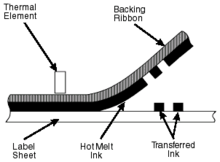
Back Thermodruck#Thermotransferdruck German 溶融型熱転写印刷 Japanese 열전사 인쇄 Korean Termopārneses druka Latvian/Lettish Thermische overdrachtsprinter Dutch Drukarka termotransferowa Polish Impressora de transferência térmica Portuguese Vaxskrivare Swedish

| Part of a series on the |
| History of printing |
|---|
 |
Thermal-transfer printing is a digital printing method in which material is applied to paper (or some other material) by melting a coating of ribbon so that it stays glued to the material on which the print is applied. It contrasts with direct thermal printing, where no ribbon is present in the process.
Thermal transfer is preferred over direct thermal printing on surfaces that are heat-sensitive or when higher durability of printed matter (especially against heat) is desired. Thermal transfer is a popular print process particularly used for the printing of identification labels. It is the most widely used printing process in the world for the printing of high-quality barcodes. Printers like label makers can laminate the print for added durability.
Thermal transfer printing was invented by SATO corporation. The world's first thermal-transfer label printer SATO M-2311 was produced in 1981.[1]
- ^ "Company Profile" (PDF). Sato Global. Retrieved 15 September 2022.